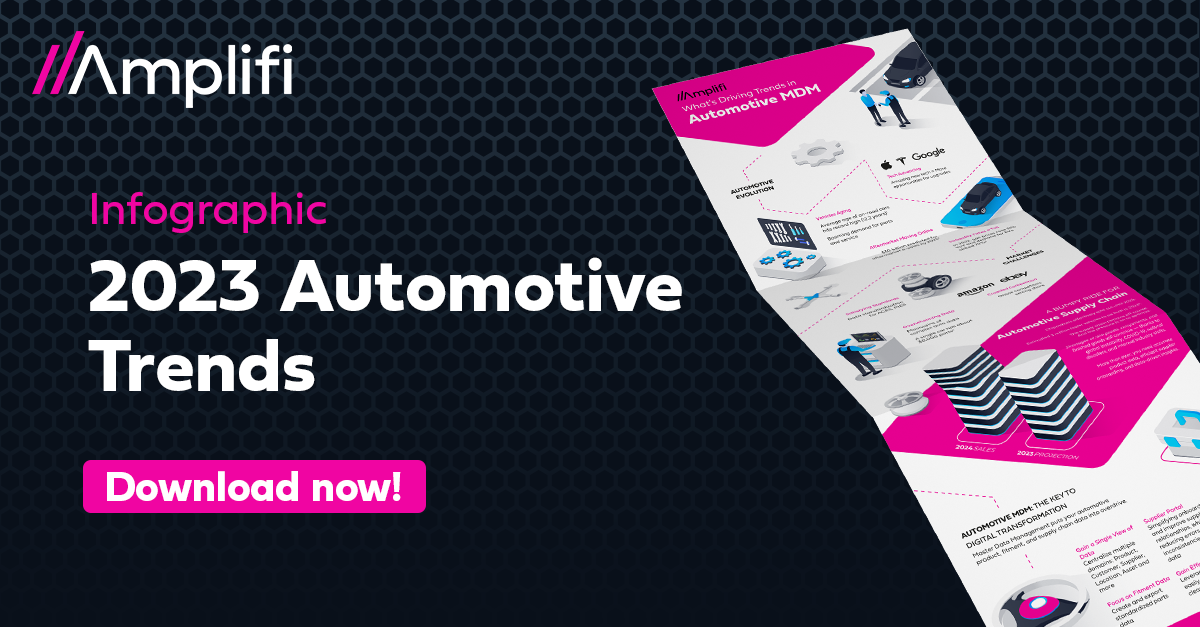Automotive manufacturers operate in the fast lane of a competitive industry. High customer demand, market fluctuations, and supply chain disruption can push your business to its limits.
Just like a race car needs a pitstop to get its tires changed and engine checked, your manufacturing business needs a pitstop to get your data in check. That’s where product information management (PIM) can help.
Recently, Amplifi and Stibo Systems sat down to chat about the biggest challenges automotive manufacturers face with their data. This blog dives into our top four takeaways — including how PIM can help. Let’s look at four major roadblocks that impact your manufacturing business — and how to use PIM to drive your business success.
Recommended Infographic: PIM or MDM — What’s the Difference?
#1: Trouble scaling due to scattered data and manual processes
Data is the foundation of nearly every manufacturing business. And the automotive industry is no different. As a manufacturer, you rely on accurate and complete data to make and sell parts and products — whether for business-to-business (B2B) or direct-to-consumer (D2C).
A plethora of part numbers, fitment data, vehicle configurations, pricing, and naming nomenclatures can be overwhelming. Employees often waste hours and even days sorting, searching, and correcting bad data. Recently, an IDC survey found that data workers spend a full 44% of their workday on unsuccessful data activities.
So, how does PIM help? Instead of multiple systems, hundreds of spreadsheets, and countless wasted hours, you gain a single source of data truth for your product catalog. Data updates can be made quickly and at scale. And with automated workflow, employees gain the efficiency they need to focus on growing their business.
#2: Difficulty updating data for automotive standards like ACES and PIES
The automotive industry continues to transform into the digital age, where fitment data is expected in industry standard formats.
What are the most important standards? You can read about them here.
As a quick recap, meeting standards defined by Auto Cares, the Aftermarket Catalog Exchange Standard (ACES), Product Information Exchange Standard (PIES), NAPA, and TecDoc are necessary to deliver enriched content to your customers.
Manually updating product and fitment data to meet industry standards can drain your team’s time and focus. And if you fail to stay compliant, you may disappear from the customers’ view — leading them to purchase from a competitor.
When configured to accommodate aftermarket standards, PIM can help you:
- Easily establish relationships between product and fitment data (at scale).
- Create workflows that help your data stewards maintain compliance.
- Build accuracy and completeness rules to catch any fitment data errors before publishing to online catalogs and channels.
Tip: Not every partner understands the nuances of ACES, PIES, NAPA, and TecDoc. Find a proven PIM or MDM partner that speaks your language.
#3: Adopting new car technology amidst major supply chain disruption
Recently, the demand for Electric Vehicles (EVs) skyrocketed. In the first half of 2022 alone, 4.3 million EVs were sold globally — an increase of 62% from the year prior.
While ripe with opportunity, this market trend stresses an already inundated supply chain. For example, vehicle demand is higher than chip supply, and Aftermarket News notes that 3 million fewer vehicles will be built in 2023 as a result.
Economic and geopolitical factors may be outside your control. However, PIM can help you move parts and products through every stage of your supply chain as smoothly as possible.
For example, data around how to properly pack, ship, receive, and store items helps ensure timely delivery and prevents damage/loss of goods. You can also create triggers for replenishment—based on factors like cost, customer demand, current stock levels, and availability—to optimize your inventory.
#4: Meeting the evolving demands of automotive digital commerce
Automotive eCommerce—especially for aftermarket parts—is booming. Online sales for automotive parts grew by 21.3% in 2021, and experts expect this trend to continue.
Not only are wholesalers, retailers, and repair establishments shopping online at higher rates, but consumers want to buy automotive parts to complete repair jobs independently. Sites like eBay Motors attract new D2C customers every day.
With e-commerce booming, many automotive companies want to expand their digital presence. Thankfully, one of the greatest strengths of PIM is the ability to support the e-commerce experience with:
- Accurate, consistent, and complete product information to inform purchasing decisions.
- Product attributes that power online search/filter, comparison charts, and product discovery.
- Accurate pricing specific to quantity, region, customer, or inventory availability.
- Product recommendations based on “like” or “next best” products, or other rules and relationships you establish.
- Seamless syndication of your product information to marketplaces like eBay, Amazon, and other popular sites for aftermarket parts.
- Digital assets that give customers a better understanding of your product, including images or downloadable PDFs.
Because of these features, leveraging PIM can put you ahead of the competition as you adapt to the rise of automotive e-commerce. By delivering enriched content, you can boost sales, win and retain loyal customers, and lower the likelihood of product returns.
Does your product data need a tune-up?
For automotive manufacturers struggling with their data, PIM can be a great place to start. With the right processes, people, and technology, you can see a rapid time to value.
Plus, once you have the right foundation, you can leverage other types of data—like supplier or location—to transform your business. Want to learn how? We’ll dive into that topic in our next post.
Gear up by downloading our 2023 Automotive Data Trends infographic


